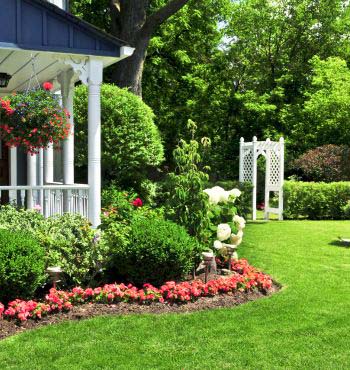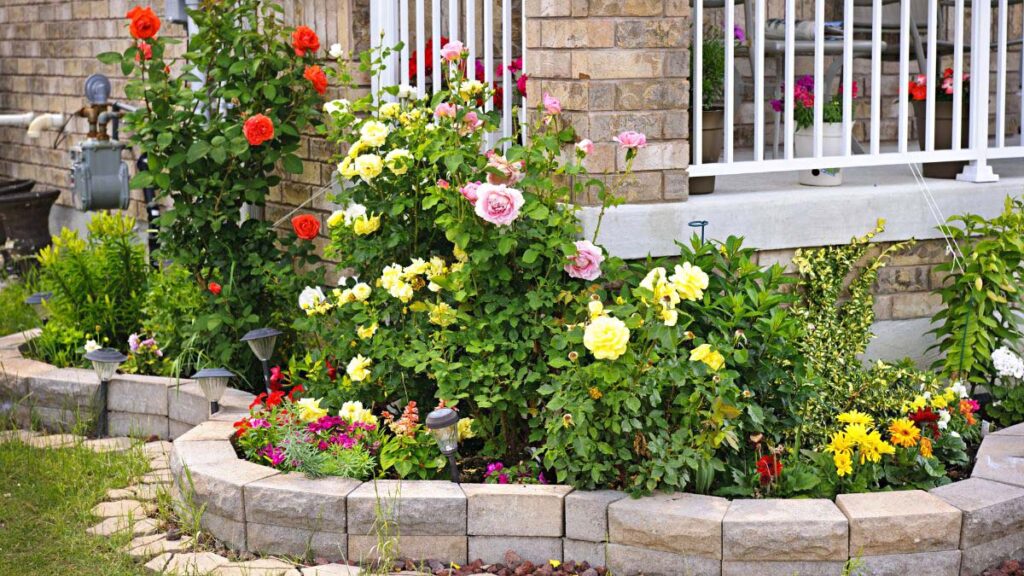A front yard vegetable garden is a productive and space-efficient way to grow your own fresh produce at home. With the rising interest in sustainable living and the desire for organic, healthy food, more and more people are turning their front yards into thriving gardens.
Not only does a front yard vegetable garden provide a source of nutritious food, but it also adds beauty and curb appeal to your home. By utilizing raised beds or containers, you can make the most of the available space and easily customize the layout of your garden.
With careful planning and maintenance, you can enjoy a bountiful harvest right outside your front door.
The Benefits Of Front Yard Vegetable Gardens
Transforming your front yard into a vegetable garden not only embellishes your landscape but also provides a fresh and sustainable source of produce. By cultivating your own fruits and vegetables, you can lead a greener, healthier lifestyle, reduce your carbon footprint, and promote food security in your community.
The Benefits of Front Yard Vegetable Gardens Front yard vegetable gardens have gained popularity in recent years, as more and more homeowners are realizing the numerous benefits they offer. In this section, we will explore some of these benefits, focusing on how front yard vegetable gardens enhance sustainability and promote health and wellness.
Enhancing Sustainability
Front yard vegetable gardens play a crucial role in enhancing sustainability by offering a range of environmental benefits.
- Conservation of Resources: By growing your own food in your front yard, you can reduce your reliance on grocery stores, which often transport produce over long distances. This reduces the carbon footprint associated with food transportation and helps conserve valuable resources.
- Reduced Food Waste: With a front yard vegetable garden, you have better control over the amount of food you grow, reducing the likelihood of excess food going to waste. Plus, any food scraps that you do have can be composted and used to nourish your garden, closing the nutrient cycle.
- Preservation of Biodiversity: Front yard vegetable gardens provide opportunities to grow heirloom and rare varieties of vegetables, helping to preserve biodiversity and protect endangered plant species. By cultivating diverse plants, you play a vital role in supporting pollinators and beneficial insects.
- Water Conservation: With careful planning and management, front yard vegetable gardens can be designed to minimize water usage. Techniques such as mulching, drip irrigation, and rainwater harvesting can go a long way in conserving water and making your garden more sustainable.

Promoting Health And Wellness
Front yard vegetable gardens not only benefit the environment but also have a positive impact on our health and well-being. Here are some ways in which they promote a healthier lifestyle:
- Access to Fresh and Nutritious Food: When you have a front yard vegetable garden, you have easy access to fresh, homegrown produce. This means you can enjoy nutritious meals with a higher vitamin and mineral content compared to store-bought produce, which often loses nutrients during transportation and storage.
- Physical Activity: Maintaining a front yard vegetable garden requires physical work, such as digging, planting, weeding, and harvesting. This regular exercise not only improves cardiovascular health but also helps increase strength, flexibility, and overall fitness.
- Mental Well-being: Spending time in nature and tending to your garden can have a positive impact on your mental well-being. Gardening has been proven to reduce stress levels, improve mood, and boost overall mental health. It provides a sense of accomplishment and satisfaction as you watch your vegetables grow and thrive.
- Teaching and Learning: Front yard vegetable gardens offer an excellent opportunity to teach children about the importance of sustainable living, healthy food choices, and the joy of growing their own food. By involving them in garden activities, you help instill lifelong skills and knowledge.
Overall, front yard vegetable gardens bring about a multitude of benefits, ranging from environmental sustainability to improved health and well-being. By harnessing the power of nature, we can create a more resilient and vibrant community right in our front yards.
Planning Your Front Yard Vegetable Garden
When it comes to creating a flourishing front yard vegetable garden, careful planning is essential. By taking the time to assess sunlight and soil quality, as well as choosing the right vegetables for your specific conditions, you can ensure a bountiful harvest. Here, we’ll explore these crucial steps in detail.
Assessing Sunlight And Soil Quality
To maximize the growth and productivity of your front yard vegetable garden, it’s important to carefully assess the amount of sunlight your garden receives and the quality of your soil. Here’s how you can do it:
- Determine the hours of direct sunlight your front yard receives each day. Observe the areas that are shaded or receive partial sunlight, as they might influence your plant choices.
- Test the quality of your soil by taking a small sample from different areas of your front yard. Use a soil testing kit or consult with a local gardening center to evaluate the pH level and nutrient content of your soil.
- Consider the drainage capabilities of your soil. If it retains water excessively, you may need to amend it with organic matter or create raised beds for better moisture management.
Choosing The Right Vegetables
Once you’ve assessed your front yard’s sunlight and soil quality, it’s time to select the right vegetables that are suitable for your growing conditions. Consider the following factors:
- Climate: Choose vegetables that are well-adapted to your local climate. Research which vegetables thrive in your zone and are resistant to common pests and diseases in your area.
- Space: Evaluate the available space in your front yard and choose vegetables that can fit within that area. Consider the height and width of the plants as they mature, as well as any trellises or supports they may require.
- Growing Season: Determine the length of your growing season and select vegetables that can be successfully grown within that timeframe. Some plants require longer growing periods, while others can be harvested quickly.
- Personal Preference: Plant vegetables that you and your family enjoy eating. This ensures that the effort and time put into your front yard vegetable garden will be rewarded with produce that you love.
By assessing sunlight and soil quality, as well as carefully choosing the right vegetables, you can lay the foundation for a successful front yard vegetable garden. With proper planning, you’ll be well on your way to enjoying the beauty and bounty of your garden for many seasons to come.

Designing And Layout Of The Garden
When planning a front yard vegetable garden, the design and layout play a crucial role in maximizing space and creating an attractive outdoor space. From incorporating aesthetics to utilizing vertical space, careful consideration of the garden’s layout can ensure a bountiful and visually appealing harvest.
Incorporating Aesthetics
Incorporating aesthetics into the front yard vegetable garden design not only enhances the overall appeal of the space but also integrates it harmoniously into the landscape. By incorporating colorful vegetables, decorative planters, and garden art, the vegetable garden can blend seamlessly with the overall aesthetic of the front yard while demonstrating the beauty of edible landscaping.
Utilizing Vertical Space
Utilizing vertical space is a smart approach to maximize the limited area in a front yard. Trellises, vertical planters, and hanging containers can be used to grow vining vegetables or herbs, freeing up valuable ground space for other crops. Additionally, vertical gardening can create an eye-catching display while increasing the garden’s overall productivity.
Maintaining Your Front Yard Vegetable Garden
Maintain your front yard vegetable garden effortlessly with these practical tips for optimal growth and health. Enhance your curb appeal and enjoy fresh produce right at your doorstep.
Maintaining your front yard vegetable garden is essential to ensure healthy and abundant yields of delicious homegrown produce. Two key aspects of garden maintenance are proper watering and irrigation, as well as managing pests and weeds. These play a crucial role in the overall health and productivity of your vegetables. In this section, we will explore some effective strategies for watering and irrigation, as well as ways to manage pesky pests and weeds that may threaten your garden.
Watering And Irrigation
Proper watering is vital for the growth and development of your front yard vegetable garden. Ensuring that your plants receive adequate water will help them thrive and produce bountiful harvests. Here are some tips to optimize your watering and irrigation practices:
- Water deeply: When watering your vegetable garden, aim to water deeply rather than shallowly. Deep watering encourages the roots to grow deeper into the soil, resulting in stronger and more resilient plants. Watering deeply also helps prevent water evaporation from the surface of the soil.
- Mulch to retain moisture: Applying a layer of organic mulch around your vegetable plants can help retain moisture in the soil, reducing the frequency of watering needed. The mulch acts as a barrier, preventing water from evaporating and keeping the soil consistently moist.
- Install a drip irrigation system: Consider installing a drip irrigation system in your front yard vegetable garden. Drip irrigation delivers water directly to the plant’s root zone, minimizing water waste and ensuring that each plant receives the right amount of moisture.
- Water at the right time: It’s best to water your front yard vegetable garden early in the morning or late in the evening when temperatures are cooler. This allows the water to penetrate the soil effectively without excessive evaporation.
Managing Pests And Weeds

Pests and weeds can quickly jeopardize the health and productivity of your front yard vegetable garden. Taking proactive measures to manage these challenges is crucial. Here are some effective pest and weed management strategies:
- Integrated pest management: Employ an integrated approach to pest management, which includes cultural, biological, and physical controls. Encourage beneficial insects like ladybugs, lacewings, and praying mantises that help naturally control pests. Additionally, handpicking pests such as caterpillars or using insecticidal soaps can be effective.
- Regularly inspect your plants: Regularly inspect your vegetable plants for signs of pests or diseases. Early detection allows for quick action, preventing any potential infestations from spreading.
- Weed diligently: Keeping your front yard vegetable garden free from weeds is essential to prevent competition for nutrients and moisture. Regularly remove weeds by hand or use organic mulches to suppress their growth.
- Crop rotation: Implementing crop rotation practices can help reduce pest and disease issues. By rotating your vegetable crops each season, you disrupt pest life cycles and prevent the buildup of soil-borne diseases.
By following these tips for watering and irrigation and effectively managing pests and weeds in your front yard vegetable garden, you can foster a healthy and thriving growing environment for your plants. These simple practices will lead to abundant harvests of delicious, homegrown vegetables to enjoy throughout the season.
Harvesting And Utilizing The Produce
Harvesting and utilizing the produce from your front yard vegetable garden is an exciting and rewarding experience. Not only do you get to enjoy the satisfaction of growing your own food, but you also have the opportunity to optimize crop yield and get creative in the kitchen with your homegrown vegetables. In this blog post, we will explore some tips for maximizing the productivity of your garden and share ideas for using the harvested produce in delicious and nutritious recipes.
Optimizing Crop Yield
Growing a productive front yard vegetable garden starts with choosing the right plants for your climate and considering the space available. By selecting vegetables that thrive in your region and planting them in areas with adequate sunlight and fertile soil, you can optimize your crop yield.
Here are some key factors to keep in mind:
- Choose disease-resistant varieties that are well-suited to your growing conditions.
- Rotate your crops each year to prevent soil depletion and minimize the risk of pest infestations.
- Practice proper watering techniques to promote healthy growth and prevent plant stress.
- Implement organic pest control methods, such as companion planting and natural insect repellents.
- Regularly monitor your plants for signs of nutrient deficiencies or disease and take appropriate action.

Creative Cooking With Homegrown Vegetables
Once the harvest season arrives, you’ll have an abundance of delicious and nutritious vegetables to work with. Utilize your homegrown produce in a variety of creative and tasty dishes to make the most of your bountiful harvest.
Here are some ideas to inspire your culinary adventures:
- Create vibrant salads bursting with flavor and color by combining freshly-picked greens, tomatoes, cucumbers, and herbs.
- Whip up delicious stir-fries using an assortment of homegrown vegetables like peppers, zucchini, and snap peas.
- Add depth of flavor to soups and stews with onions, carrots, and potatoes straight from your garden.
- Experiment with homemade salsas and sauces featuring juicy tomatoes, fiery peppers, and aromatic herbs.
- Preserve the flavors of summer by canning or freezing excess produce for enjoyment throughout the year.
With a little creativity and a dash of culinary curiosity, you can turn your front yard vegetable garden’s harvest into a healthy and mouthwatering feast that will impress family and friends.
FAQ For Front Yard Vegetable Garden
Can I Put A Vegetable Garden In My Front Yard?
Yes, you can have a vegetable garden in your front yard. However, check local regulations for any specific rules or restrictions that may apply. Additionally, consider the amount of sunlight your front yard receives and plan accordingly. Happy gardening!
How Can I Make My Front Yard Vegetable Garden Attractive?
To make your front yard vegetable garden attractive, use colorful plants, add decorative elements, create neat rows, and maintain clean surroundings. Use creative planters and incorporate pathways to enhance the visual appeal. Regular maintenance and proper lighting can also make the garden look inviting and beautiful.
How Do I Turn My Front Yard Into A Garden?
To turn your front yard into a garden, follow these steps:
1. Plan your garden layout considering sunlight, soil, and space.
2. Remove any existing debris or grass from the yard.
3. Prepare the soil by loosening it and adding compost or fertilizer.
4. Choose plants that thrive in your climate and suit your desired garden style.
5. Plant the chosen plants, water them regularly, and provide proper care for healthy growth.
Conclusion
Incorporating a front yard vegetable garden can enhance your home’s appeal and provide fresh, organic produce. With careful planning and maintenance, you can create a vibrant, sustainable garden that adds beauty and functionality to your outdoor space. Consider the benefits and potential challenges as you embark on this rewarding journey.






